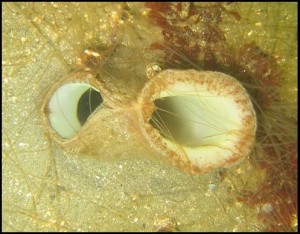The geoduck clam (also know as “Mirugai”) is a giant clam found in salt water around the coasts of the Pacific Northwest, mainly Washington State and British Columbia.
Commercial geoduck farming has only been around since the mid 90′s, and with prices topping $15/lb wholesale, has quickly become one of the most lucrative fresh seafoods grown in Washington State. To protect the young geoduck clams (“geoduck seed”) from predators, gooey ducks are placed inside of mesh tubes for the first one or two years of their lives.
Once they are mature – usually about 4-7 years, the seafood is harvested by liquifying the sand with water pressure from a hose, and then grabbing them when they float to the surface. Anyone up for a game of “bobbing for geoducks?” Today’s commercial geoduck farming is a far cry from old fashioned gooey duck digging. While enjoyment of this fresh seafood has historically been confined to the Pacific Northwest, online retailers allowing customers to buy fresh seafood online have made geoducks available to the entire world.
A Geoduck can reach 3 feet in length due to its ‘neck’ or siphon, which stretches out from the shell. Though geoduck shells are large at 7-9 inches in length, the gooey duck itself is so big that it cannot retract into the shell as other clams can.
Geoduck clams’ shells grow about 1 inch per year for the first 4 years, and reach their average size after about seven years. After this their shells thicken and they increase in weight.
The average weight of an adult fresh geoduck clam is 2 pounds. The largest recorded geoduck was weighed at about 10 pounds, though deep sea fishermen have reported much larger specimens. Gooey ducks are also one of the longest lived creatures in the world, averaging 140 years, though 168 years has been recorded. They have age rings which can be counted using a microscope, just like trees!
The name geoduck comes from a Nisqually word meaning ‘dig deep’. They are also known as the ‘king clam’ or ‘elephant trunk clam’. A gooey duck generally resides 3-4 feet deep in sand, with their siphons stretched to the surface to suck up plankton. This makes geoduck digging very difficult and has resulted in them becoming one of the most prized fresh seafoods in the world, especially in Asia where they are called Mirugai.
The siphon is the most prized part of the geoduck, due to its delicate flavor and crunchy texture. The Chinese rever the geoduck clam above most other fresh seafoods, treating it as a true delicacy. They eat it both raw as sashimi and cooked in a hot-pot similar to fondue. In sushi restaurants geoduck is listed on the menu as mirugai. Geoduck clams are also a reputed aphrodisiac, though there is no scientific evidence to support this claim.
Not surprisingly, geoduck is often misspelled or mispronounced. It is often seen spelled “Gooey Duck” or “Goeduck” and the most common mispronunciation is “Geo Duck.” Surely you didn’t make this mistake? Now you know better!
So now what? Geoduck’s (Goeducks? Gooey ducks?) are tricky creatures – we suggest you learn how to Prepare Geoduck!
Ready to buy geoduck or other fresh seafood online? Order gourmet seafood online from our partner Here and get fresh seafood delivered to your doorstep!


